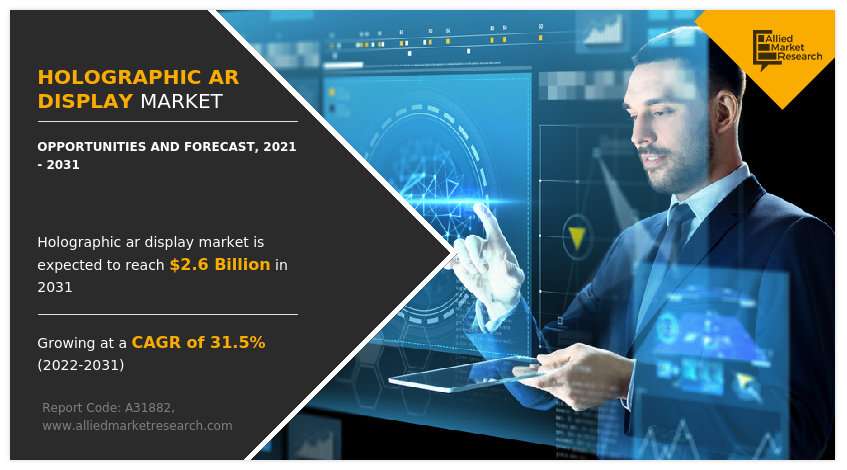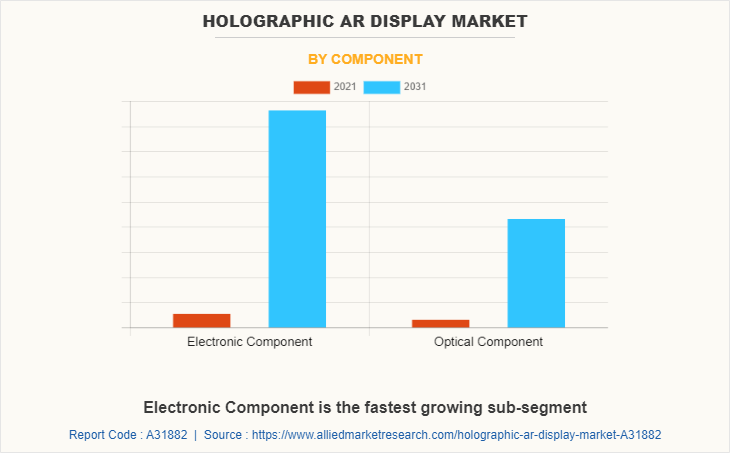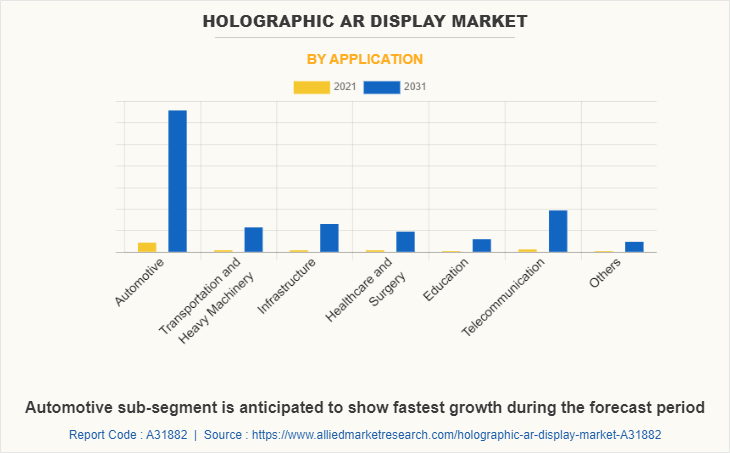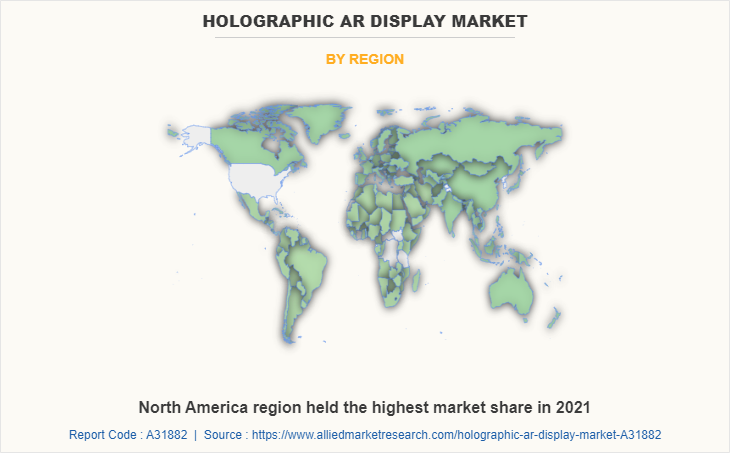Holographic AR Display Market Insights, 2031
The global holographic ar display market was valued at USD 170.3 million in 2021, and is projected to reach USD 2.6 billion by 2031, growing at a CAGR of 31.5% from 2022 to 2031.
The surge in demand for holographic AR displays for medical applications such as endoscopy and X-ray drives the holographic display market growth during the forecast period. In addition, increase in the usage of holographic displays for advertising and events promotes the holographic display market rapid expansion. All these are the major factors anticipated to drive the market revenue growth in the upcoming years.

A holographic display is used to create realistic three-dimensional (3D) images. It uses light diffraction to generate a holographic effect. It is used in a variety of sectors as a successful marketing and advertising tool to generate brand awareness and boost sales. Several manufacturers are already developing advanced product variations that can display 3D pictures of aerial maps. They include micro pistons that act similarly to pixels on a computer display, helping to enhance overall image quality.
The high cost of manufacturing holographic display devices is limiting the market expansion. Manufacturing holographic devices is an expensive procedure, which may be prohibitively costly for small companies. As a consequence of this issue, it is anticipated that the final cost of the product would be expensive and not all customers in developing countries will be able to afford it. These factors are projected to restrain the growth of the holographic AR display market during the forecast period.
The holographic AR display offers immersive experience to the users where the users can interact with the digital elements in virtual environment. Holographic AR displays have great potential in other sectors including education, telecommunication, infrastructure, construction, and healthcare. AR sensors are used in cameras and screens to connect digital information with the real physical world and efficiently transform it with holographic visuals. Holographic displays are expected to be used more in dentistry, medical, and health science education. Holographic AR displays provide an excellent opportunity to enhance education especially medical studies. All these factors are anticipated to create growth opportunities for the key players operating in the market during the forecast period.
The key players profiled in this report include WayRay AG., Continental AG, Visteon Corporation, Sygic, DigiLens Inc., Indiegogo, Inc., Futurus Group, and Avegant Corp.
The global holographic AR display market is segmented on the basis of component, application, and region. By component, the market is divided into electronic component and optical component (diffractive optical element (DOE) and holographic optical element (HOE)). By application, the market is classified into automotive, transportation and heavy machinery, infrastructure, healthcare and surgery, education, telecommunication, and others. By region, the market is analyzed across North America, Europe, Asia-Pacific, and LAMEA. The holographic ar display market is segmented into Component and Application.

By component, the electronic component sub-segment dominated the market in 2021. Holography and digital computational technologies were substantially merged to create the new technological discipline of electronic component holography. Holography displays capture and replicate 3-D images by using optical wavefronts. In order to generate a picture, the collected interference pattern modifies an illumination beam. The dispersed wavefront from the object scene is diffracted by the modulated light and then reproduced in three components. These factors are projected to drive the sub-segment growth.

By application, the automotive sub-segment dominated the market in 2021. Holographic AR displays are used in vehicles to lower the sight shift of the driver from the road. In addition, holographic AR displays increase the comfort of the driver which is expected to drive its adoption in the automotive sector. The use of holographic displays, however, is predicted to shift from high-end automobiles to mid-range and lower-range vehicles during the forecast period. These are predicted to be the major factors affecting the holographic AR display market size during the forecast period.

By region, North America dominated the global market in 2021. The U.S. dominates the holographic AR display industry due to the presence of large market players and a greater rate of technological adoption. In addition, a sizable expenditure for advertising from numerous businesses is projected to boost market expansion during the forecast period. Furthermore, the region is a growing market for hologram display players due to the profusion of many electronics and vehicle manufacturing companies.
Impact of COVID-19
- COVID-19 has negatively impacted various industries such as automotive that has led to a drastic decline in automotive sales. As holographic AR display is widely used in automotive, there was a significant reduction in the holographic AR display demand globally.
- Sales of holographic AR displays are directly proportional to the demand from end-use industries namely the automotive, electronic, retail, packaging, and others. However, the demand for holography AR displays in the automotive industry was greatly affected owing to import-export restrictions, closed borders, and supply chain disruptions due to the outbreak of the COVID-19 pandemic.
- The economic slowdown has affected the setup of new holography AR display projects across the world as the majority of government funding was diverted toward the healthcare sector owing to the rapid spread of the COVID-19 virus, impacting the market to the great extent.
Key Benefits for Stakeholders
- The report provides an exclusive and comprehensive analysis of the global holographic AR display market share along with the holographic AR display market forecast
- The report elucidates the holographic AR display market opportunity along with key drivers, and restraints of the market. It is a compilation of detailed information, inputs from industry participants and industry experts across the value chain, and quantitative and qualitative assessment by industry analysts.
- Porter’s five forces analysis helps analyze the potential of the buyers & suppliers and the competitive scenario of the market for strategy building
- The report entailing the holographic AR display market analysis maps the qualitative sway of various industry factors on market segments as well as geographies for the analysis of holographic AR display market trends
- The data in this report aims at market dynamics, trends, and developments affecting the holographic AR display market growth
Holographic AR Display Market Report Highlights
| Aspects | Details |
| Market Size By 2031 | USD 2.6 billion |
| Growth Rate | CAGR of 31.5% |
| Forecast period | 2021 - 2031 |
| Report Pages | 270 |
| By Component |
|
| By Application |
|
| By Region |
|
| Key Market Players | Sygic, Continental AG, WayRay AG, Visteon Corporation, Futurus Group, Avegant Corp., Indiegogo, Inc., DigiLens Inc. |
Analyst Review
The rapid adoption of holographic displays by the retail sector has been one of the primary driving factors of the market growth. Increase in deployment of holographic displays in public places such as shopping malls, trade shows, and stores to draw customer attention will also significantly affect the market growth in the coming years. Increase in the popularity of holographic displays among the population is predicted to boost the market growth during the forecast period. However, the high cost of these displays and lack of awareness about holographic AR displays is expected to hamper the market growth. The increase in the use of holographic AR displays in advertising and events, as well as the rise in demand for holographic displays in the healthcare industry, are two major factors driving the holographic AR display market expansion. These factors are anticipated to significantly create growth prospects for the key players operating in the market during the forecast period.
Among the analyzed regions, North America is expected to account for the highest revenue in the market by the end of 2031, followed by Asia-Pacific, Europe, and LAMEA. Rise in electronic and automotive industrialization is the key factor responsible for the leading position of North America and Asia-Pacific in the global holographic AR display market.
The global holographic AR display market was valued at $170.3 million in 2021 and is projected to reach $2.6 billion by 2031.
The holographic AR display market is projected to grow at a compound annual growth rate of 31.5% from 2022 to 2031.
WayRay AG., Continental AG, and Visteon Corporation are the top companies to hold highest market share in the holographic AR display market.
North America is the largest regional market for holographic AR display market.
An increase in demand for holographic AR displays in the medical industry and an increase in adoption rates for advertising, events, and others are driving the growth of the holographic AR display market. In addition, technological advancements and the proliferation of smartphones are expected to provide significant growth opportunities for the global market players during the forecast period. Modern technological advancements and display enhancements are also expected to contribute to the growth of the holographic display market.
Loading Table Of Content...



